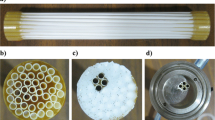Abstract
Crossflow microfiltration (CFMF) is a better technique for removal of particles from water suspension. Clogging is the main drawback of membrane application, which causes a drop in permeate flux. Numerous techniques are available for flux improvement. In this work, three such techniques backflushing, pulsation and in-line flocculation, are reviewed. Two experimental studies have been analyzed and compared. In both techniques, better flux was reported with cleaning frequency of 1min. This shows that a longer interval causes increased internal clogging and deposition. However for the backflushing case, longer duration of backflushing produced higher flux improvement, while pulsating performed inconsistently with stop duration. Net permeate volume was observed higher in both experiments when Tf= 1min, Tb=1 sec and Tf=1 min, Ts=1 sec. This is due to higher flux at Tf=1min and longer net operation time. Comparing the flux improvement in both techniques without flocculent addition, backflushing produced 200% increment at Tf=1 min and Tb=5 sec. This was 63% at Tf=1min and Ts=1 sec with pulsating. Flux increment was 162% with backflushing at Tf=1 min and Tb=1 sec.
Similar content being viewed by others
References
Al-Malack, M. H. and Anderson, G. K., “Use of crossflow microfiltration in wastewater treatment,”Wat. Res.,31, 3064 (1997).
Barlett, M., Bird, M. R. and Howell, J. A., “An experimental study for the development of a qualitative membrane cleaning model,”J. Membr. Sci.,105, 147 (1995).
Bhattacharjee, C., “Analysis of continuous stirred ultrafiltration based on dimensional analysis approach,”Korean J. Chem. Eng.,21, 556 (2004).
Blanpain-Avet, P., Doubrovine, N., Lafforgue, C. and Lalande, M., “The effect of oscillatory flow on crossflow microfiltration of beer in a tubular mineral membrane system-membrane fouling resistance decrease and energetic considerations,”J. Membr. Sci.,152, 151 (1999).
Chen, D. W.,Application of microfiltration with backflush technique in water treatment, Membrane Engineering Thesis, Asian Institute of Technology, Thailand, EV-90-6 (1990).
Connell, H., Zhu, J. and Bassi, A., “Effect of particle shape on crossflow filtration flux,”J. Membr. Sci.,153, 121 (1999).
Dharmappa, H. B. and Hagare, P., “Economic analysis and design of crossflow microfiltration for water treatment systems,”Desalination,121, 1 (1999).
Gan, Q., Howell, J. A., Field, R. W., England, R., Bird, M. R. and Mckechinie, M. T., “Synergetic cleaning procedure for ceramic membrane fouled by beer microfiltration,”J. Membr. Sci.,155, 277 (1999).
Guo, W. S., Vigneswaran, S. and Ngo, H. H., “Effect of flocculation and/ or adsorption as pretreatment on the critical flux of crossflow microfiltration,”Desalination,172, 53 (2005).
Kwon, D. Y. and Vigneswaran, S., “Influence of particle size and surface charge on critical flux of crossflow microfiltration,”Wat. Sci. and Tech.,38, 481 (1998).
Li, J., Sanderson, R. D., Chai, G. Y. and Hallbauer, D. K., “Development of an ultrasonic technique for in site investigation the properties of deposited protein during crossflow ultrafiltration,”J. Colloid and Interface Sci.,284, 228 (2005).
Lim, K. H. and Park, S. W., “The treatment of waste-air containing mixed solvent using a biofilter. 1. Transient behavior of biofilter to treat waste-air containing ethanol,”Korean J. Chem. Eng.,21, 1161 (2004).
Lim, K. H. and Park, S. W., “The treatment of waste-air containing mixed solvent using a biofilter. 2. Treatment of waste-air containing ethanol and toluene in a biofilter,”Korean J. Chem. Eng.,22, 228 (2005).
Madaeni, S. S., Mohamamdi, T. and Moghadam, M. K., “Chemical cleaning of reverse osmosis membranes,”Desalination,134, 77 (2001).
Meier, J., Klein, G. M. and Kottke, V., “Crossflow filtration as a new method of wet classification of ultrafine particles,”Separation and Purification Tech.,26, 43 (2002).
Thiruvenkatachari, R., Shim, W. G., Lee, J. W. and Moon, H., “Powdered activated carbon coated hollow fiber membrane: preliminary studies on its ability to limit membrane fouling and to remove organic materials,”Korean J. Chem. Eng.,22, 250 (2005).
Thomassen, J. K., Faraday, D. B. F., Underwood, B. O. and Cleaver, J. A. S., “The effect of varying transmembrane pressure and crossflow velocity on the microfiltration fouling of a model beer,”Separation and Purification Tech.,41, 91 (2005).
Author information
Authors and Affiliations
Corresponding author
Rights and permissions
About this article
Cite this article
Roh, SH., Shin, HJ. & Kim, SI. Backflushing, pulsation and inline flocculation techniques for flux improvement in crossflow microfiltration. Korean J. Chem. Eng. 23, 391–398 (2006). https://doi.org/10.1007/BF02706740
Received:
Accepted:
Issue Date:
DOI: https://doi.org/10.1007/BF02706740




